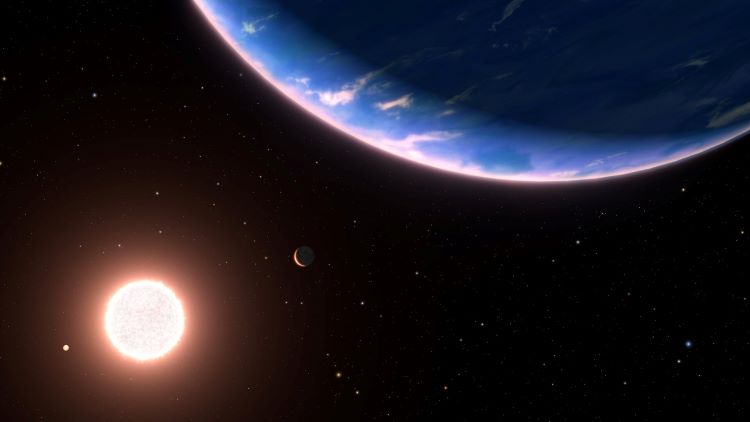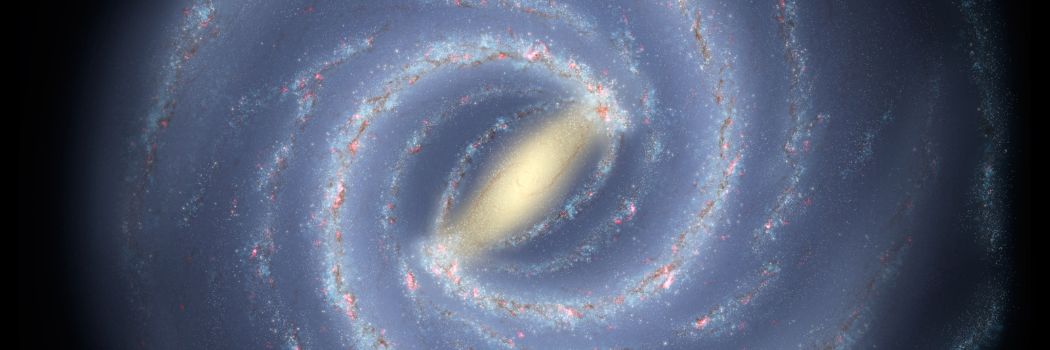Anyone familiar with astronomy will know that galaxies come in a fairly limited range of shapes, typically; spiral, elliptical, barred-spiral and irregular. The barred-spiral galaxy has been known to be a feature of the modern universe but a study from astronomers using the Hubble Space Telescope has recently challenged that view. Following on observations using the James Webb Space Telescope has found the bar feature in some spiral galaxies as early as 11 billion years ago suggesting galaxies evolved faster in the early Universe than previously expected.
Continue reading “Galaxies Evolved Surprisingly Quickly in the Early Universe”Uh oh. Hubble's Having Gyro Problems Again

The Hubble Space Telescope has gone through its share of gyroscopes in its 34-year history in space. Astronauts replaced the gyros during the last servicing mission in 2009, bringing it back up to six (three with three spares), but they only last so long. Last week, HST went into safe mode because one of the gyros experienced fluctuations in power. NASA paused the telescope’s science operations today to investigate the fluctuations and perhaps come up with a fix.
With this one gyro experiencing problems, only two of the gyros remain fully operational. HST works best with three gyros, and so engineers are working to understand the issue and hopefully figure out a way to fix it remotely. However, several years ago, engineers figured out a way to still conduct science operations with only a single gyro.
Continue reading “Uh oh. Hubble's Having Gyro Problems Again”Brown Dwarf Pairs Drift Apart in Old Age
![An artist's conception of a brown dwarf. A new study identifies CK Vulpeculae as the remnant of a collison between a brown dwarf and a white dwarf. Image: By NASA/JPL-Caltech (http://planetquest.jpl.nasa.gov/image/114) [Public domain], via Wikimedia Commons](https://www.universetoday.com/wp-content/uploads/2018/10/Artist’s_conception_of_a_brown_dwarf_like_2MASSJ22282889-431026-2000x1200.jpg)
The only thing worse than drifting through space for an eternity is doing it alone. Observations with the Hubble Space Telescope show that brown dwarfs that once had companions suffer that fate. Binary brown dwarfs that were once bound to each other tend to drift apart as time passes.
Continue reading “Brown Dwarf Pairs Drift Apart in Old Age”Webb Continues to Confirm That Universe is Behaving Strangely

Over a century ago, astronomers Edwin Hubble and Georges Lemaitre independently discovered that the Universe was expanding. Since then, scientists have attempted to measure the rate of expansion (known as the Hubble-Lemaitre Constant) to determine the origin, age, and ultimate fate of the Universe. This has proved very daunting, as ground-based telescopes yielded huge uncertainties, leading to age estimates of anywhere between 10 and 20 billion years! This disparity between these measurements, produced by different techniques, gave rise to what is known as the Hubble Tension.
It was hoped that the aptly named Hubble Space Telescope (launched in 1990) would resolve this tension by providing the deepest views of the Universe to date. After 34 years of continuous service, Hubble has managed to shrink the level of uncertainty but not eliminate it. This led some in the scientific community to suggest (as an Occam’s Razor solution) that Hubble‘s measurements were incorrect. But according to the latest data from the James Webb Space Telescope (JWST), Hubble’s successor, it appears that the venerable space telescope’s measurements were right all along.
Continue reading “Webb Continues to Confirm That Universe is Behaving Strangely”It's Time for Jupiter's Annual Checkup by Hubble

Each year, the Hubble Space Telescope focuses on the giant planets in our Solar System when they’re near the closest point to Earth, which means they’ll be large and bright in the sky. Jupiter had its photos taken on January 5-6th, 2024, showing off both sides of the planet. Hubble was looking for storm activity and changes in Jupiter’s atmosphere.
Continue reading “It's Time for Jupiter's Annual Checkup by Hubble”Now You Can See Exactly Where Hubble and JWST are Pointed
Hubble and JWST are busily scanning the sky, sending home enormous amounts of data. They shift from target to target, completing the required observations.
But have you ever wondered what those two space telescopes are doing right at this moment? Now, you can do just that at the new Space Telescope Live website. It will show you what each observatory is scanning, where the objects are in the sky, and what researchers hope to learn. You can even go back or forward in time and see what each telescope has been looking at in the past or what observations are coming up.
Continue reading “Now You Can See Exactly Where Hubble and JWST are Pointed”Water Vapor Found in the Atmosphere of a Small Exoplanet

A recent study published in The Astrophysucal Journal Letters discusses the detection of water within the atmosphere of GJ 9827 d, which is a Neptune-like exoplanet located approximately 97 light-years from Earth, using NASA’s Hubble Space Telescope (HST), and is the smallest exoplanet to date where water has been detected in its atmosphere. This study was conducted by an international team of researchers and holds the potential to identify exoplanets throughout the Milky Way Galaxy which possess water within their atmospheres, along with highlighting the most accurate methods to identify the water, as well.
Continue reading “Water Vapor Found in the Atmosphere of a Small Exoplanet”This Strange-Looking Galaxy is Actually Two. And They're Merging

This strange-looking galaxy seems to be a spiral with a long tidal tail stretching away. It’s known as Arp 122, and it’s actually not just one galaxy, but two separate galaxies. NGC 6040 is the warped spiral galaxy seen edge-on, while LEDA 59642 is the round, face-on spiral. The two are colliding about 540 million light-years from Earth, and it gives us a preview of the Milky Way’s future collision with Andromeda.
This image was taken by the venerable Hubble Space Telescope
What will Arp 122 look like when the merger is complete? We’ll try to keep you posted, but this ongoing merger will take hundreds of millions of years, so be patient.
Continue reading “This Strange-Looking Galaxy is Actually Two. And They're Merging”JWST and Chandra Team Up for a Stunning View of Supernova Remnant Cassiopeia A

NASA’s long-lived Chandra X-ray Observatory teamed up with JWST for the first time, producing this incredibly detailed image of the famous supernova remnant Cassiopeia A. JWST first looked at the remnant in April 2023, and noticed an unusual debris structure from the destroyed star, dubbed the “Green Monster.” The combined view has helped astronomers better understand what this unusual structure is, plus it uncovered new details about the explosion that created Cas A.
Continue reading “JWST and Chandra Team Up for a Stunning View of Supernova Remnant Cassiopeia A”Hubble Sees a Random Collection of Galaxies, Perfectly Lined Up

This new image from the Hubble Space Telescope looks like a series of smaller spiral galaxies are falling out of a larger and brighter galaxy. That’s just one of the many reasons this collection of galaxies belongs to the Arp-Madore catalogue of peculiar galaxies.
Continue reading “Hubble Sees a Random Collection of Galaxies, Perfectly Lined Up”

